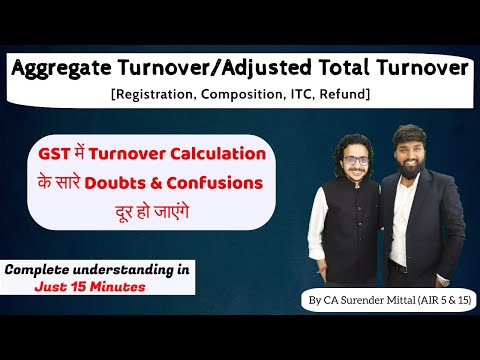Key Takeaways
- Aggregate Turnover is a critical GST metric, including all taxable, exempt, non-taxable supplies, and exports, minus GST taxes.
- It determines GST registration eligibility, which is critical for businesses surpassing specified revenue thresholds.
- Essential for Composition Scheme Eligibility, offering simplified tax payment options for smaller turnovers.
- Influences GST Compliance and filing requirements, affect the periodicity and types of returns.
- Tax Rate Applicability may vary based on aggregate turnover, affecting SMEs significantly.
Any firm, especially those operating under the Goods and Services Tax (GST) regime in India, must understand the idea of aggregate turnover. This important indicator has an impact on many organizational operations, including strategic planning and tax compliance.
This article will provide you a comprehensive understanding of the topic by explaining the significance, approach, and relevance of total income.
Purpose of Aggregate Turnover
In the realm of GST, is a pivotal term that signifies the aggregate value of all taxable and non-taxable supplies, exempt supplies, and exports of goods and/or services made by a person, excluding taxes levied under GST. It’s a metric that determines a business’s eligibility for GST registration, tax payments, and other benefits such as input tax credit (ITC).
In the context of the Goods and Services Tax (GST) regime, this notion is quite important since it determines different compliance and eligibility requirements for taxpayers.

It is the sum of all the taxable and non-taxable supplies, exempt supplies, exports of goods and/or services, and inter-state supplies of a person with the same Permanent Account Number (PAN). However, it does not include the value of incoming supplies that are subject to reverse charge tax, central tax, state tax, Union Territory tax, integrated tax, and cess.
- Determining GST Registration Eligibility: One of the primary purposes of calculating aggregate turnover is to determine whether a business exceeds the threshold limit for GST registration. The GST law specifies the threshold limits, and businesses must register for GST if their revenue exceeds these limits. This makes it a critical factor for businesses to assess their registration obligations.
- Eligibility for the Composition Scheme: Aggregate turnover is also crucial in determining the eligibility of businesses for the GST Composition Scheme. This scheme allows qualifying businesses with revenue below a certain threshold to pay GST at a fixed rate on their revenue, simplifying tax calculations and compliance requirements. Therefore, knowing one’s gross helps in deciding whether to opt for this scheme.
- Compliance and Filings: For registered businesses, revenue influences the periodicity of GST returns and the type of forms to be filed. For example, businesses with smaller revenue may qualify for quarterly returns under the QRMP (Quarterly Return Monthly Payment) scheme, reducing the compliance burden.
- Tax Rate Applicability: In some cases, it can influence the GST rate applicable to a business. Certain notifications or schemes may offer differential tax rates or exemptions based on turnover thresholds, aiming to support small and medium-sized enterprises (SMEs).
- Inter-State Supplies: Understanding one’s aggregate turnover is essential for businesses engaged in inter-state supplies, as it affects their liability to register under GST and comply with the Integrated GST (IGST) provisions.
- Input Tax Credit (ITC) Eligibility: While total revenue itself does not directly impact input tax credit eligibility, it does influence the overall compliance landscape of a business, including the accurate reporting and claiming of ITC based on outward supplies.
- Market Analysis and Business Planning: Beyond regulatory compliance, aggregate provides valuable insights for business analysis and planning. By understanding their overall revenue, businesses can benchmark their performance, plan for expansion, and make strategic decisions regarding their market positioning and growth trajectories.
Inclusions in Aggregate Turnover
In the Goods and Services Tax (GST) framework in India, aggregate turnover is a comprehensive metric that includes the total value of certain types of transactions made by a taxpayer across India, excluding the home state.
Understanding what is included in aggregate turnover is crucial for businesses for GST compliance, including registration, eligibility for various schemes, and determining filing requirements. Here’s a breakdown of the inclusions in aggregate turnover:
- Taxable Supplies: This includes the value of all supplies on which GST is levied, including supplies of goods and services both to consumers and for business purposes. It encompasses supplies made under the reverse charge mechanism as well, where the recipient is liable to pay the tax.
- Exempt Supplies: These are supplies of goods and services that are exempt from GST. Even though no GST is charged on these supplies, they are included in the aggregate revenue. This includes supplies that are wholly exempt from tax under GST and supplies that are not taxable under the act.
- Non-taxable Supplies: Supplies that are outside the purview of GST are considered non-taxable supplies. An example is the sale of alcohol for human consumption, which is not subject to GST but is included in the calculation of aggregate turnover.
- Exports of Goods and/or Services: The total value of all goods and services exported outside India is included in the aggregate turnover. Exports are treated as zero-rated supplies under GST, allowing exporters to claim refunds on the input tax credit.
- Inter-state Supplies: The aggregate turnover includes the value of all supplies made from one state to another, reflecting the comprehensive nature of this metric. It encompasses supplies made to both registered and unregistered persons.
Exclusions in Aggregate Turnover
In the realm of Goods and Services Tax (GST) in India, while the concept of aggregate turnover encompasses a wide range of transactions to ascertain a taxpayer’s compliance obligations, certain exclusions are specifically outlined to provide clarity and fairness in the calculation.
Understanding these exclusions is crucial for businesses to accurately determine their GST liabilities and eligibility for various schemes and thresholds. Here are the key exclusions from aggregate turnover under the GST regime:
- Inward Supplies Subject to Reverse Charge: Purchases or inward supplies on which the recipient is liable to pay tax under the reverse charge mechanism (RCM) are excluded from the aggregate turnover. This is because the concept of aggregate revenue is designed to reflect a taxpayer’s outward trade activities, not the taxes paid on inward supplies.
- Central, State, Union Territory, Integrated, and Cess Taxes: The various components of GST (Central GST, State GST, Union Territory GST, Integrated GST) and cesses are not included in the aggregate turnover. This exclusion ensures that the turnover calculation reflects the value of supplies themselves rather than the tax component added to those supplies.
- Value of Supplies between Distinct Persons: Under GST, supplies made between branches or units of the same legal entity in different states (distinct persons as per GST) are not included in aggregate turnover for the purpose of determining eligibility for registration or schemes. However, for the calculation of aggregate revenue at the national level for a single entity, these inter-branch supplies are considered.
- Transactions in Securities: Trading in securities, such as stocks, bonds, or derivatives, is not considered a trade under GST. Consequently, the value of transactions in securities is excluded from the calculation of aggregate turnover.
- Goods Supplied on Approval Basis Returned: Goods that are sent on an approval basis but are returned to the supplier within the prescribed period are excluded from aggregate turnover. This consideration prevents the inflation of gross figures with transactions that do not result in a final sale.
Special Category States
“Special Category States” refers to a group of states that receive special consideration and benefits due to their unique geographical, economic, and socio-political challenges. These states are typically those with challenging terrain, low population density, strategic international borders, or socio-economic backwardness.

The special category status aims to address these challenges by providing these states with preferential treatment in terms of GST regulations, including lower threshold limits for GST registration, among other benefits.
As of my last update, the following states and territories were recognized as Special Category States under the GST regime:
- Arunachal Pradesh
- Assam
- Jammu & Kashmir
- Manipur
- Meghalaya
- Mizoram
- Nagaland
- Sikkim
- Tripura
- Himachal Pradesh
- Uttarakhand
Additionally, some Union Territories are also given special considerations under GST:
- Andaman and Nicobar Islands
- Lakshadweep
Key Benefits and Considerations for Special Category States
- Lower Threshold for GST Registration: One of the main benefits for businesses in special category states is the lower threshold limit for GST registration. This means small traders and service providers with lower annual revenue can benefit from the exemption from GST registration, compared to the threshold limits applicable in other states. This is designed to support small-scale industries and businesses in these regions.
- Composition Scheme Eligibility: Special category states also enjoy a lower threshold for eligibility to opt into the GST Composition Scheme, which allows qualifying businesses to pay GST at a reduced rate while simplifying compliance requirements.
- Higher Rate of Central Assistance: While not directly related to GST, it’s noteworthy that special category states receive a higher rate of central assistance for centrally sponsored schemes and projects. This reflects the overall intent of the Indian government to support the economic development of these regions.
- Special Provisions: The GST Council, which is the governing body responsible for making recommendations to the Union and State Government on issues related to GST, may recommend special provisions for special category states to address their unique challenges. These provisions can include special rates, exemptions, and other measures aimed at supporting the local economy and businesses.
How to calculate aggregate turnover?
Calculating aggregate turnover is a fundamental step for businesses to determine their GST obligations, including registration and eligibility for various schemes under the GST framework.
Aggregate includes the total value of taxable supplies, exempt supplies, exports of goods and services, and inter-state supplies of a person having the same PAN, to be computed on an all-India basis. Here’s a step-by-step guide on how to calculate aggregate turnover:
Step 1: Identify All Revenue Streams
Start by identifying all your revenue streams across India. This includes all taxable, exempt, and non-taxable supplies, as well as exports and inter-state supplies. It’s important to consider all operations under the same PAN.
Step 2: Aggregate Taxable Supplies
Sum up the total value of all taxable supplies made during the financial year. Taxable supplies include all goods and services that are chargeable to GST at any rate.
Step 3: Include Exempt Supplies
Add the value of all exempt supplies to your total. Exempt supplies are those that are not subject to GST or are specifically exempted under GST law. This includes both goods and services.
Step 4: Add Non-taxable Supplies
Non-taxable supplies, such as alcohol for human consumption (which is outside the purview of GST), should also be included in the aggregate turnover calculation.
Step 5: Include the Value of Exports
Include the total value of all exports of goods and services. Exports are treated as zero-rated supplies under GST, but their value counts towards the aggregate revenue.
Step 6: Sum Up Inter-state Supplies
Add the value of all supplies made from one state to another. This includes supplies to both registered and unregistered persons across state lines.
Step 7: Exclude Inward Supplies on Reverse Charge
Do not include the value of inward supplies on which tax is paid on a reverse charge basis. These are not considered in the calculation of aggregate turnover.
Step 8: Exclude Taxes from the Value of Supplies
When calculating the aggregate revenue, exclude the GST component (CGST, SGST, IGST, and cess) from the value of supplies. Only the value of the goods or services should be included.
Step 9: Consolidate All Figures
Combine the values from steps 2 through 6, ensuring that you’ve excluded the components mentioned in steps 7 and 8. The resulting figure represents your aggregate turnover.
Which is not inclusive?
A common misconception in calculating Turnover is the inclusion of inward supplies and personal consumption. It’s critical to note that these are not part of the calculation, which focuses solely on outward supplies.
Difference between Aggregate Turnover and Turnover in a State
The distinction between “aggregate turnover” and “turnover in a state” is crucial for businesses navigating the Goods and Services Tax (GST) framework in India. These terms have specific meanings and implications for GST registration, compliance, and eligibility for various schemes. Here’s a breakdown of the differences:

Aggregate Turnover
- Definition: Aggregate turnover refers to the total value of all taxable and non-taxable supplies, exempt supplies, exports of goods and/or services, and inter-state supplies of a person having the same Permanent Account Number (PAN), across all states and union territories. It is calculated on an all-India basis.
- Scope: It encompasses the total revenue from all operational units of a business across India under the same PAN. This includes both intra-state and inter-state transactions.
- Purpose: The concept of aggregate turnover is primarily used to determine GST registration eligibility. Businesses whose aggregate turnover exceeds the prescribed threshold must register for GST. It is also used to ascertain eligibility for the Composition Scheme and other compliance requirements under GST.
- Exclusions: Aggregate turnover does not include inward supplies on which tax is paid under the reverse charge mechanism (RCM), taxes levied under the GST (such as CGST, SGST, IGST, and cess), and transactions between branches within the same state.
Turnover in a State
- Definition: Turnover in a state refers to the aggregate value of all taxable and non-taxable supplies, exempt supplies, and exports of goods and/or services made within a single state or union territory. It is specific to one state, or UT, and does not include inter-state supplies.
- Scope: This term focuses on the revenue generated from transactions within a particular state or union territory, under a specific GSTIN (GST Identification Number). It captures the economic activity of a business within that state’s boundaries.
- Purpose: Turnover in a state is important for filing state-specific GST returns and determining state-level tax liabilities. It affects the computation of SGST (State GST) and helps in the apportionment of revenue between states.
- Exclusions: Similar to aggregate turnover, turnover in a state does not include inward supplies on which tax is paid under RCM, taxes under the GST, or inter-state supplies. However, it is confined to transactions within a particular state, or UT.
Key Differences
- Geographical Scope: Aggregate turnover is calculated on a pan-India basis, including all transactions under a PAN, whereas turnover in a state is restricted to transactions within a specific state or UT.
- Use in GST Compliance: Aggregate turnover is used to assess GST registration eligibility and eligibility for the Composition Scheme on a national level. In contrast, turnover in a state is relevant for state-specific GST compliance and calculations.
- Calculation Basis: Aggregate turnover includes inter-state supplies, making it a broader measure of a business’s total revenue for GST purposes. Turnover in a state focuses solely on the economic activities within that state’s or UT’s boundaries.
Relevance of Aggregate Turnover
The amount of money that a business makes is very important when it comes to the Goods and Services Tax (GST) in India. It affects many things, like compliance, registration, and being able to use schemes within the GST framework. Aggregate serves as a cornerstone metric for determining a taxpayer’s obligations and entitlements under GST. Here are key points that underscore its relevance:
GST Registration
- Threshold Limit: Aggregate turnover is a critical factor in determining whether a business exceeds the threshold limit for mandatory GST registration. Businesses with an aggregate exceeding the specified limit (which varies for goods and services and may differ across states, including special category states), are required to register for GST.
This threshold helps in identifying small businesses that can benefit from lesser compliance burdens.
Eligibility for the Composition Scheme
Simplified Taxation: Businesses with an aggregate below a certain threshold can opt for the Composition Scheme, which allows them to pay GST at a reduced rate. This scheme simplifies tax compliance and reduces the tax burden for small and medium-sized enterprises (SMEs).
The threshold for eligibility is a crucial determinant for businesses considering this scheme.
Compliance Requirements
Filing Returns: The aggregate turnover of a taxpayer influences the periodicity and type of GST returns they must file. For instance, taxpayers with a lower turnover have the option to file returns quarterly under the QRMP (Quarterly Return Monthly Payment) scheme, reducing compliance costs and efforts.
Input Tax Credit (ITC)
While aggregate turnover does not directly impact eligibility for claiming ITC, it affects the overall compliance framework within which a business operates. A thorough understanding of aggregate turnover helps in better financial and tax planning, including the efficient utilization of ITC.
Inter-State and Intra-State Transactions
Determining Tax Liabilities: Aggregate turnover includes the value of all inter-state supplies, which is essential for determining a business’s liability under the Integrated Goods and Services Tax (IGST) versus the Central Goods and Services Tax (CGST) and State Goods and Services Tax (SGST).
Strategic Business Decisions
Expansion and Scaling: Knowing the aggregate turnover helps businesses make informed decisions regarding expansion, scaling, and entering new markets. It provides a clear picture of the business’s size and scale, guiding strategy around GST implications.
Sector-Specific Implications
Certain sectors may have specific regulations or exemptions based on aggregate turnover. Understanding these nuances is crucial for businesses operating in or entering such sectors.
Audit and Legal Compliance
Aggregate turnover is a key metric for GST audit purposes. Businesses exceeding a certain turnover threshold may be subject to audit by a chartered accountant or a cost accountant, ensuring compliance with GST laws and regulations.
Conclusion
The concept of aggregate turnover is central to the GST framework, serving as a crucial determinant for GST registration, compliance obligations, and eligibility for beneficial schemes like the Composition Scheme. It impacts both the strategic and operational aspects of businesses, guiding them in tax planning, financial decision-making, and regulatory compliance.
By accurately calculating and understanding their aggregate turnover, businesses can navigate the GST regime more effectively, ensuring compliance, optimizing tax liabilities, and making informed decisions for growth and expansion.
Thus, aggregate turnover is not just a measure of business size but a key to unlocking the complexities of the GST system in India, underscoring its importance in the broader context of business operations and tax administration.
💡Get started with PICE today and streamline your GST payments and export invoicing process. Click here to sign up and take the first step towards hassle-free GST management.
FAQs
What is aggregate turnover?
Aggregate turnover is a crucial metric under GST (Goods and Services Tax) that represents the total value of all taxable and non-taxable supplies, exports of goods and/or services, and inter-state supplies made by a person or business across India, under the same PAN, excluding inward supplies on which tax is paid by reverse charge and taxes such as CGST, SGST, IGST, and cess. It is used to determine GST registration eligibility and compliance requirements.
How is aggregate turnover different from turnover in a state?
Aggregate turnover is the sum of all the taxable and exempt supplies, exports, and inter-state supplies that a business in India makes under the same PAN. It excludes inward supplies that are subject to reverse charge and other GST taxes. In contrast, turnover in a state refers to the aggregate value of all taxable and non-taxable supplies, including exports and inter-state supplies, made within a single state or union territory. Essentially, aggregate turnover is a nationwide calculation, while turnover in a state focuses on transactions within that specific state or territory.
Why is aggregate turnover important for GST?
Aggregate turnover is crucial for GST as it determines a business’s eligibility for GST registration, based on predefined turnover thresholds. It affects the applicability of various tax slabs and exemptions, ensuring businesses are taxed appropriately for their scale of operations. Furthermore, understanding aggregate turnover is essential for availing input tax credits and complying with GST filing requirements, thereby streamlining tax administration and promoting fair taxation practices across different sectors.
How can one accurately calculate aggregate turnover?
To accurately calculate aggregate turnover for GST, one must include the total value of all taxable supplies, exempt supplies, exports of goods and/or services, and inter-state supplies made under the same PAN across India. It’s crucial to exclude inward supplies that require reverse charge tax payment as well as GST taxes like CGST, SGST, IGST, and cess. Regularly updating financial records and ensuring comprehensive inclusion of all relevant transactions are key steps for an accurate calculation.
What are the implications of getting the aggregate turnover calculation wrong?
Incorrectly calculating aggregate turnover can have significant implications, including wrongful GST registration or non-compliance, leading to penalties and interest. If turnover is underestimated, a business may fail to register for GST when required, missing out on input tax credits and facing compliance issues. Overestimation could unnecessarily subject a business to GST obligations and administrative burdens. Thus, accuracy in calculating aggregate turnover is crucial for adhering to GST regulations and optimizing tax liabilities.








